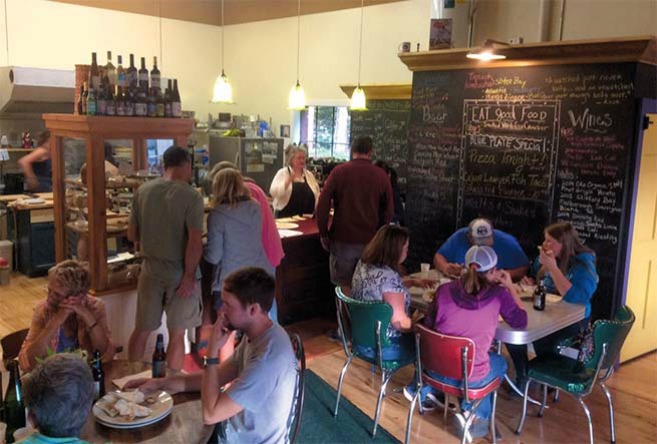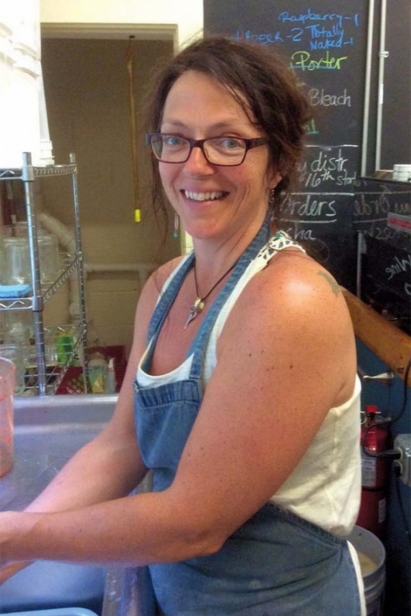Rising Star: Heidi Gilbertson of the Island Café & Bread Company
New location, but still the same island
I’ll likely never forget the first time I met Heidi Gilbertson, about six years ago. I had heard about the Washington Island-based baker from my sister, who was a regular at Heidi’s remarkably popular stand at the Sturgeon Bay Farmers Market. “You have got to try her pizza rounds!,” my sister urged. “This woman is something special.” I was drawn to the idea of locally made flatbread, but intrigued, also, by a baker who could make people rave so.
During my next visit to the island I kept intending to seek Heidi out, but it wasn’t until my husband and I pulled up to the ferry line for the return trip home that I noticed her tiny rental kitchen near the dock. I ran in to introduce myself, and somehow, in the few minutes we had together, we managed to gab about everything from the restaurants of Red Lodge, Montana and Madison, to Julia Child and the philosophy of baking.
Heidi’s signature pizza crusts weren’t available that day, so I bought two rounds of her olive bread, one to bring home and one to give to my stepmother. When my husband and I got on the boat, we couldn’t resist the warm, holy-grail smell of the bread. By the time the boat reached Northport, an entire loaf was gone. And my stepmother never did receive that second one.
In the years since our first encounter, I’ve bought many loaves of Heidi’s bread, and we’ve had myriad conversations—short and long—about cooking and cuisine, and about our shared views of life through the lens of food. In recent months I’ve also watched her plan, open and operate her new establishment, the Island Café and Bread Company.
It is a friendly, open-scheme small-town diner with big-city flavor and cachet. Heidi’s menus don’t just feature regional ingredients and handcrafted preparation, they live and breathe them. You’ll taste cross-cultural inspiration and a dedication to excellence in creations like lefse burritos, fresh whitefish tacos and beet sliders with sautéed greens, chêvre and sage brown butter. Coffee is brewed cup by cup, sweet potato coins are a signature side dish, and even the condiments shine—think homemade rhubarb jam, ramp pesto and 100-percent-real, Heidi-produced maple syrup. (And her pizzas? Oh man, don’t get me started.)
And as for Heidi herself, words like wise, generous, tireless, resilient and fearless come to mind. Indeed, after years of food and conversation together, I could write reams about this talented friend of mine. Instead, let’s let her do the talking.
Terese: You hail from southern Wisconsin. How did living there influence you?
Heidi: I grew up in the Driftless region, among farmers who came to this country from hardworking Scandinavian fishing or farming families. We raised, grew, hunted and fished much of our own food. It was a place where people appreciated and depended on the land to sustain them spiritually and physically, and I have carried that with me my whole life. I also spent my college years plus a few more in Madison where I got a degree in wildlife ecology, and where the culture of fresh and local food was gaining a foothold. I ate at the Ovens of Brittany restaurants as much as I could and grew to love that style of food and of nourishing people.
Terese: Your past jobs…how did they shape you?
Heidi: I worked as conservation biologist for the Wisconsin DNR, and for REI as a shipping-receiving specialist. Then I fell into a stint as a barista and baker at a coffee shop in Missoula, Montana. Baking was natural and fun to me. I taught myself how to make artisan bread, and in 2003 I built a wood-fired brick oven for my fi rst business, in Red Lodge. Bread became the river that ran through it all, tying the biologist and the baker inextricably together.
Terese: When did Washington Island enter the picture?
Heidi: I moved back to Wisconsin, to Washington Island, in 2008 to bake for Leah Caplan at the Washington Hotel. When the hotel closed in 2010, I decided to keep baking bread and was able to rent kitchens for the first years. Then I had another stint at the newly re-opened Hotel Washington, and then the current opportunity, the Island Cafe, presented itself. The cafe gives me the chance to fully spread my wings and create not only breads and pastries but also meals with local and fresh ingredients, to add something different to the island mix, and to get back to what I started in Montana.
Terese: Now that the cafe has been open several months, what has surprised or amazed you the most about it?
Heidi: The number of people who like my food! And the awesomeness of the staff and customers I get to spend my days with. There are so many, many details, so many balls to keep in the air and always so many people willing to help. And we make so many more meals than I ever thought possible.
Terese: What’s been the best part of it for you so far? And what’s been really hard?
Heidi: The staff, customers and support crew are by far the best, easiest, most fun part of it all, the reason it’s worth doing. The hardest part is the long hours in summer and making sure to order enough food. Having any business on an island makes many logistical hurdles because every last thing from ink cartridges to fresh fish must be handled by the ferry. It’s not always a direct or easy connection, especially if the wind is too strong for the boats to run…you may be counting on a delivery or going to market, and then unexpectedly they can’t run that day.
Terese: Tell us more about your staff and customers—all the people in your café circle.
Heidi: The people I work with are amazing. They are gardeners and moms, musicians and yogis, students, chicken ranchers and teachers… how lucky am I?! They are diligent, hard-working and outgoing; patient, kind and understanding. They put up with my insistence on being precise and consistent. So many customers are so patient and appreciative as they see their drinks or meals unfold. And there’s my amazing friends and family who have helped every step of the way on this incredible journey. Particularly Jens Hansen, the builder whose vision and talent in remodeling the space have made it that comfortable, warm place, and whose belief in what I was capable of was far stronger than mine. My suppliers are also quite supportive and determined to get the product we need into our hands. It’s such a short, manic season here, and my suppliers all seem to really get that.
Terese: Describe how you realized you wanted to be a baker—was it an “aha!” moment or more of an evolution?
Heidi: It was and continues to be both. At first, I baked for fun and to feed friends, because that’s what my grandma taught me. When I worked as a barista-baker in Missoula, I had the “aha!” when I read about making bread the old way, with natural leavening and brick ovens; that is, I realized it satisfied the biologist in me. Not everyone cares about “saving the planet,” but everyone eats food every day and if I can make it taste better and be better for them, and for the land, by using old methods and local ingredients, then I’m still doing some of my job as a conservation biologist.
Terese: Where do your ideas come from? What’s the creative process like for you?
Heidi: When I create food, I’m pulling from all over the place—old-fashioned favorites, foods that I love, conversations I’ve had, pictures, what’s in season, what’s possible to get to the island. I love to read old writings from Julia Child and M.F.K. Fisher. I try to learn from everyone.
Terese: You certainly are a make-it-from-scratch person–from maple syrup to jams to fresh bread. And you use a lot of local ingredients. Why? What are the benefi ts for you of doing it the “hard way”?
Heidi: Cutting corners or taking the quick way around is a recipe for bad food in general. The more time and care taken to prepare food, the better the results and the more enjoyment for the person consuming it. [Cooking from scratch] connects real-food ingredients with real people in real time. Using local ingredients makes a further connection—with the people who grew or raised the food. Somehow, connecting people seems to be a habit or specialty of mine. At first I wanted to call the café “Come Together”— as in, connecting people of all flavors, beliefs, ages and walks of life in a place that feels comfortable and satisfying.






